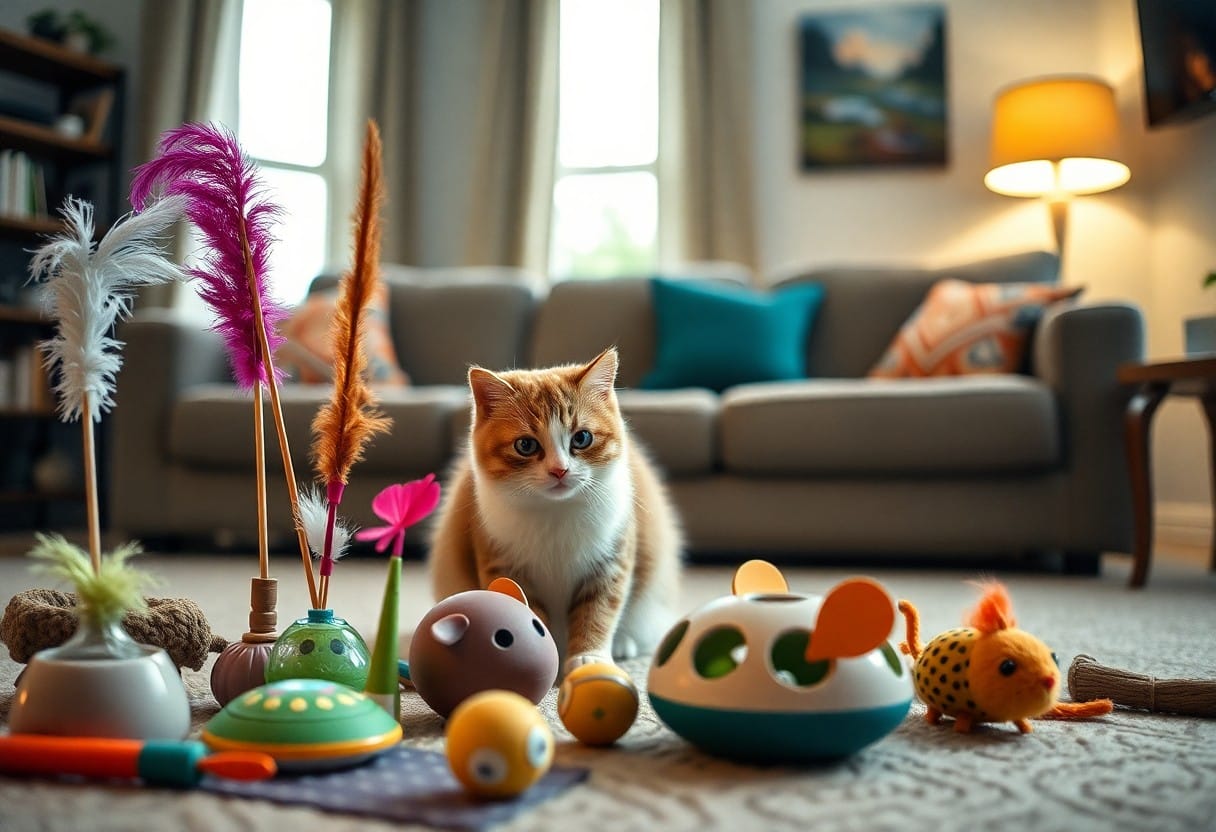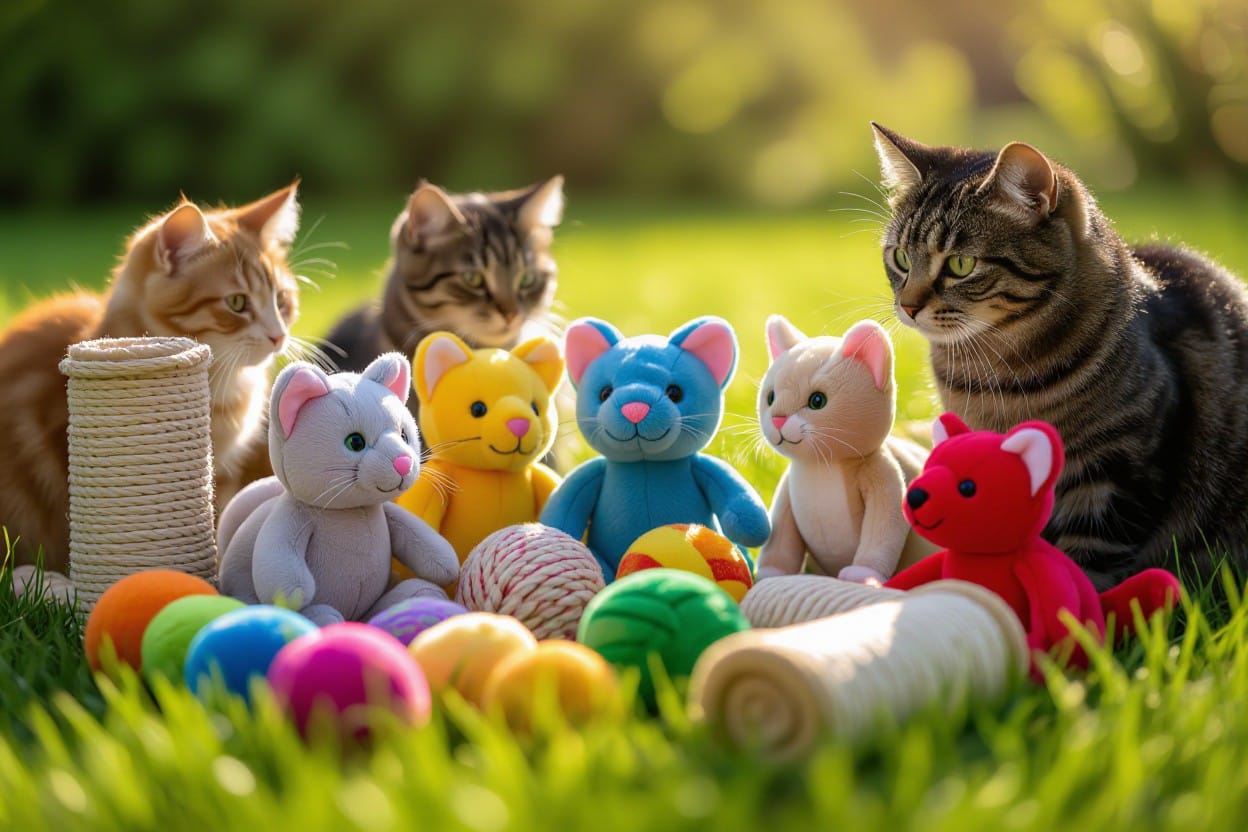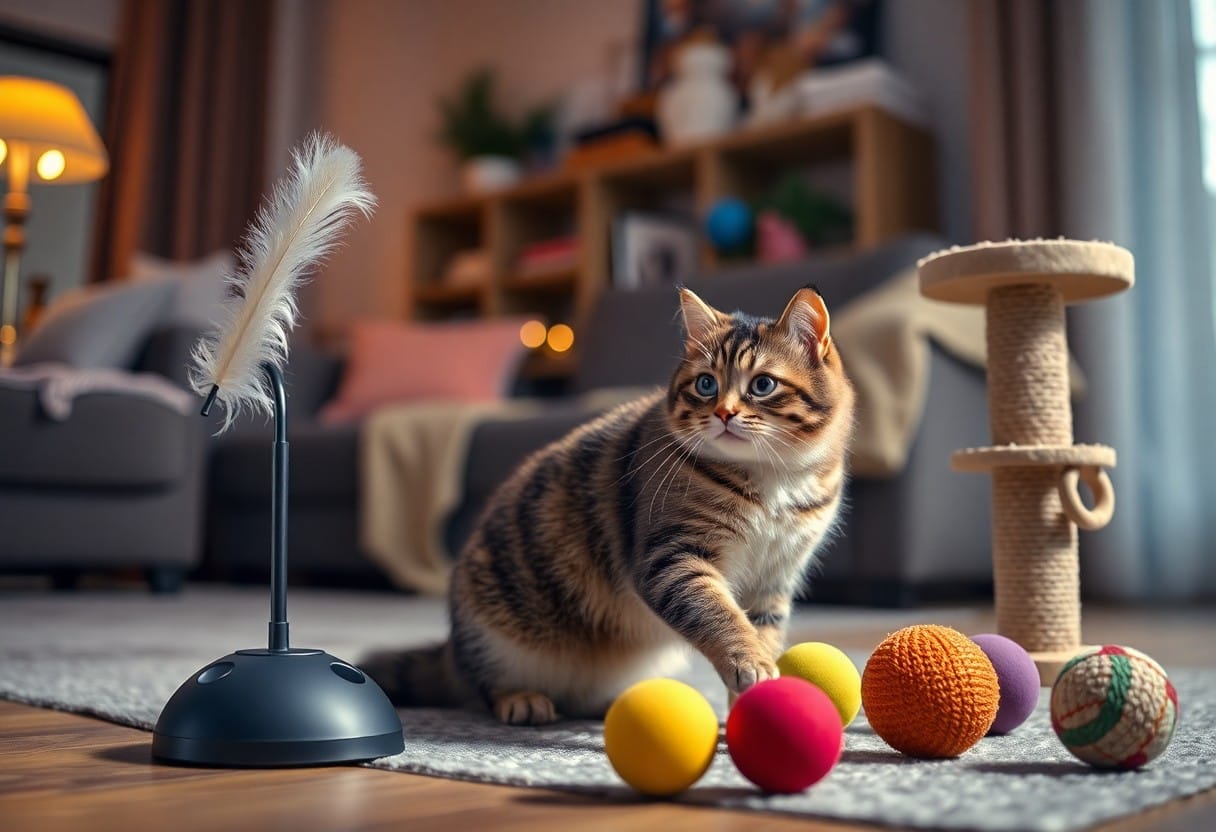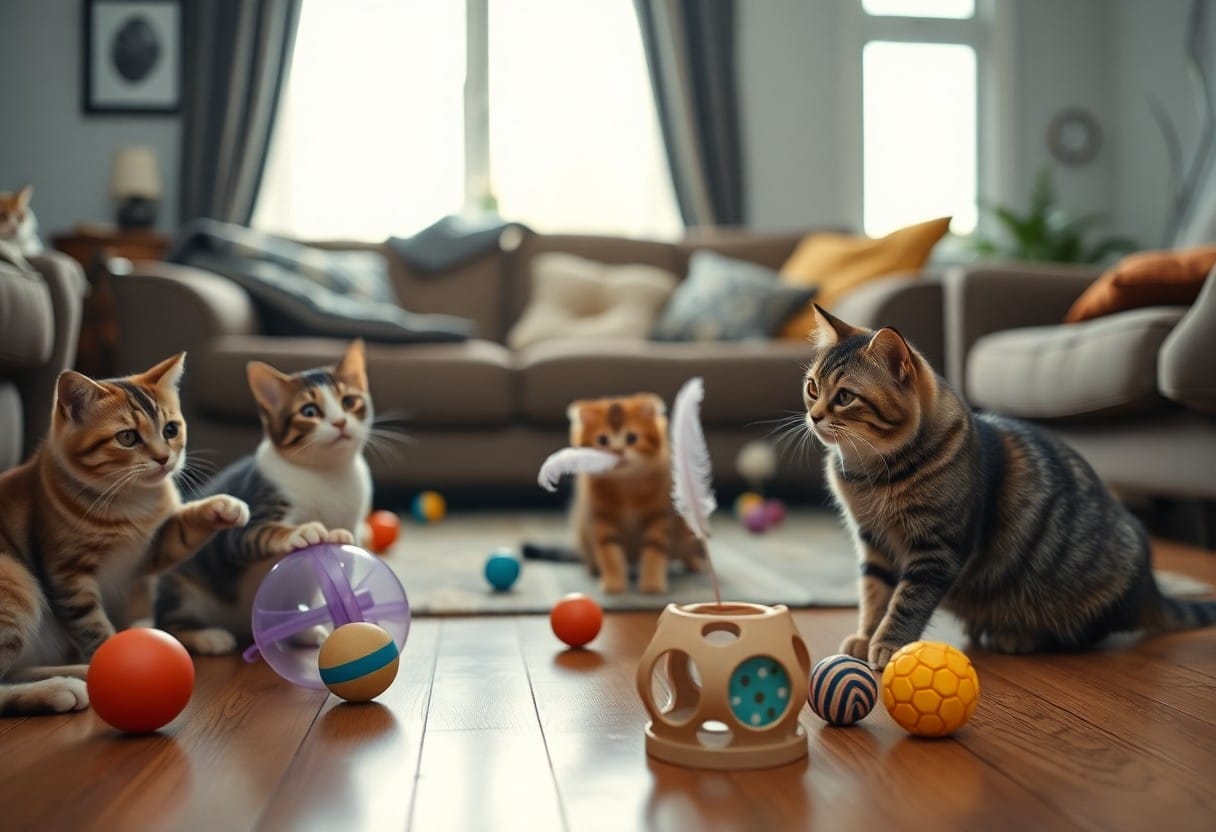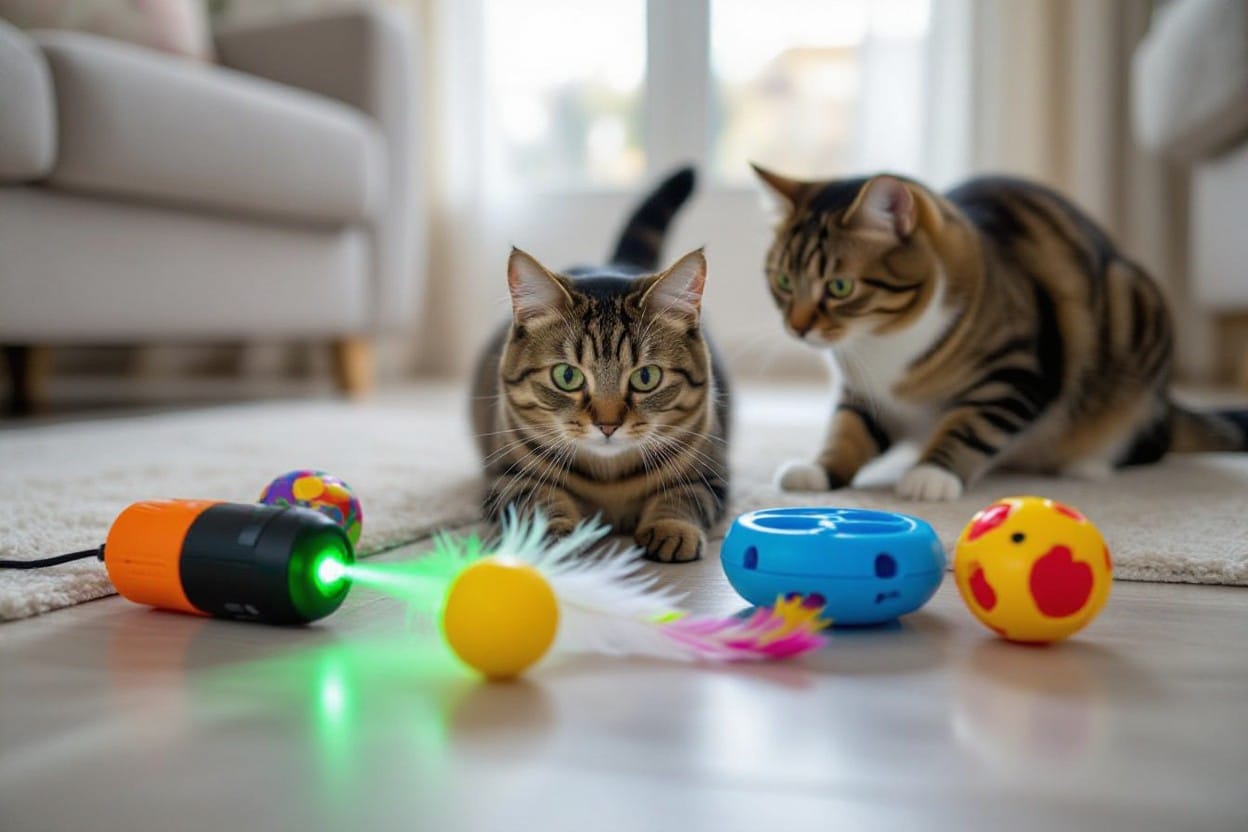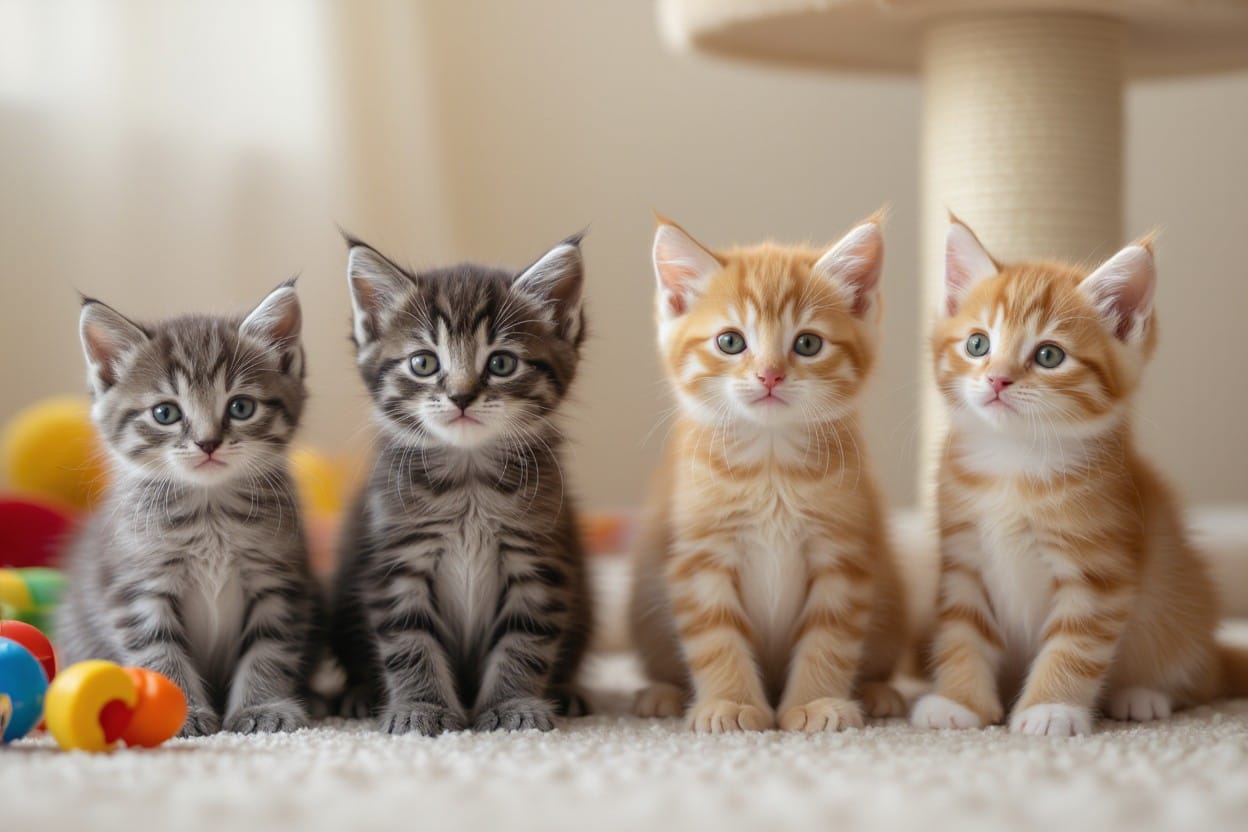With the right interactive toys, you can greatly enhance your indoor cat’s life, providing both mental stimulation and physical activity. These toys not only keep your feline entertained but also help in reducing boredom and behavioral issues. In this step-by-step guide, you’ll discover how to assess your cat’s preferences, select toys that are safe and durable, and ensure that playtime becomes a rewarding experience for both you and your furry friend. Let’s look into the imperatives of making an informed choice for your beloved pet!
Key Takeaways:
- Consider your cat’s personality and activity level when selecting interactive toys, as this will help ensure lasting engagement and enjoyment.
- Opt for toys that stimulate your cat’s natural instincts, such as hunting and playing, to encourage both physical and mental exercise.
- Look for durable materials and safety features in toys to ensure your cat’s safety and the longevity of the product during playtime.
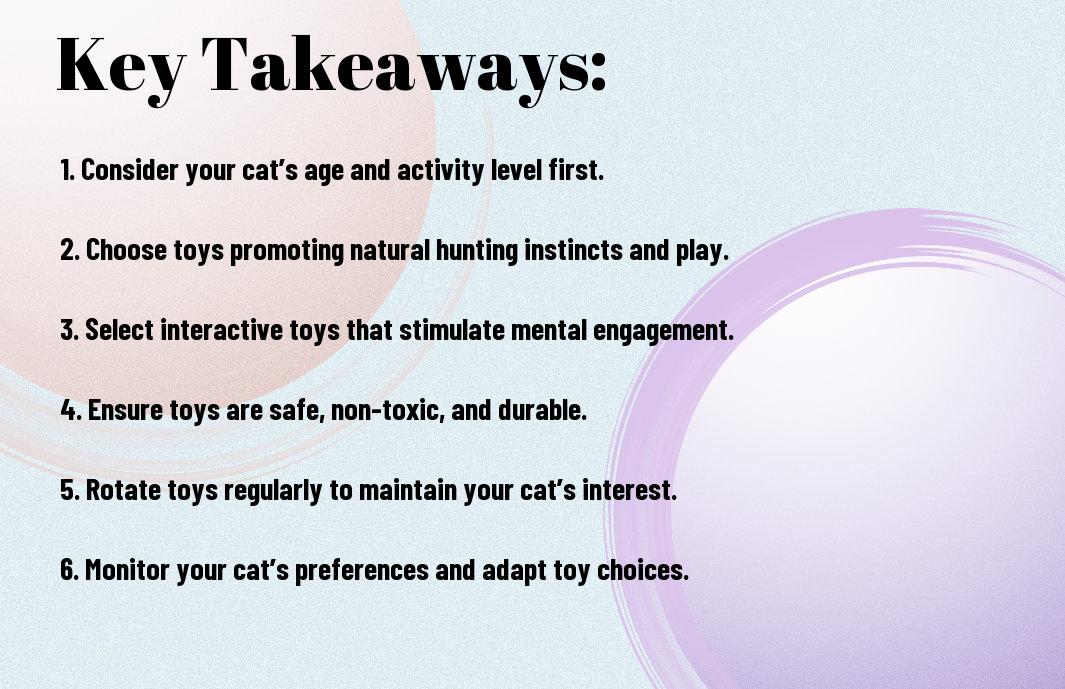
Understanding Your Cat’s Play Preferences
To effectively choose interactive toys for your indoor cat, it’s necessary to grasp their unique play preferences. Every cat is different; some may enjoy chasing, while others prefer solving puzzles. By understanding these preferences, you can enhance their playtime and promote mental and physical stimulation, leading to a happier, healthier feline companion.
Assessing Activity Levels
Play preferences often correlate with your cat’s activity levels. Active cats tend to engage more with toys that encourage movement, such as feather wands or laser pointers. Conversely, less active cats might prefer stationary puzzle feeders that allow them to think and nibble at their own pace. Observing how your cat interacts with various toys is key to determining their ideal play style.
Identifying Favorite Play Styles
To pinpoint your cat’s favorite play styles, observe their behavior during playtime. A cat that loves to chase may enjoy balls or toys that move unpredictably, whereas one that enjoys pouncing might lean towards plush toys or crumpled paper. Pay close attention to their body language; a cat that crouches and stalks is likely in hunting mode, while one that swats or captures toys shows a playful demeanor. Offering a variety of toys to test their responses will help you make informed choices; this approach fosters an engaging and enjoyable play environment for your feline friend.
Types of Interactive Toys
The selection of interactive toys can greatly enhance your cat’s playtime experience. These toys not only provide mental stimulation but also encourage physical exercise. Here’s a breakdown of some popular types:
| Electronic Toys | Engaging and automated, often mimicking prey movement. |
| Puzzle Feeders | Encourage problem-solving and slow down eating. |
| Wand and String Toys | Promote interactive play between you and your cat. |
| Ball Toys | Encourage chasing and independent play. |
| Laser Toys | Provide high-energy exercise through light stimulation. |
This diversity allows you to choose toys that fit your cat’s personality and play habits.
Electronic Toys
Against common belief, electronic toys can entertain your cat while you’re away. They often feature unpredictable movements, mimicking the erratic behavior of prey, which can captivate your feline’s attention. Options like robotic mice or toys that react to your cat’s movements can offer extended play sessions and mental engagement.
Puzzle Feeders
Interactive puzzle feeders can transform your cat’s mealtime into a stimulating game. These devices require your cat to think critically and maneuver to access their food, making feeding time more exciting.
In addition to enhancing your cat’s enjoyment during meals, puzzle feeders can improve their eating habits. They promote slower eating, which can help prevent obesity and digestive issues. By engaging your kitty’s mind and body, you’ll create a more fulfilled and less bored cat.
Wand and String Toys
At the heart of engaging play, wand and string toys encourage interaction between you and your cat. The movement of toys at the end of a string can make the playtime dynamic, allowing them to pounce and chase in a thrilling way.
Considering their active nature, these toys can significantly improve your bond with your feline friend. Always supervise play, as string toys can pose choking hazards. Choose toys with durable materials to ensure safety during those energetic play sessions.
Safety Considerations
Unlike outdoor play, where risks may be more apparent, choosing safe interactive toys for your indoor cat requires careful thought. Always consider the materials and construction of toys to ensure they don’t pose any hazards. Your cat’s safety and well-being should come first, so look for options that minimize risks associated with injury or ingestion.
Non-Toxic Materials
Among the first things to check when selecting toys for your cat is the material used in their construction. Ensure that the toys are made from non-toxic materials that won’t harm your pet if they decide to nibble or chew on them during playtime. Look for products that explicitly state they are safe for pets and comply with safety standards to keep your furry friend healthy.
Avoiding Small Parts
Above all, ensure that the toys you choose do not contain small, detachable parts that could be swallowed. These can pose serious risks of choking or internal blockage for your cat, which can lead to emergency situations requiring veterinary attention.
Even with the most engaging interactive toys, maintaining your cat’s safety should always be a priority. Pay attention to any components that are small, removable, or easily chewed off, as these pieces can create hazardous situations. Opt for sturdy toys designed with your cat’s play style in mind, as these not only provide fun but also reduce the risk of accidents and injuries. Choose wisely to ensure your indoor feline has a safe and happy environment to play in.
Budgeting for Interactive Toys
Despite the myriad of options available for interactive toys for your indoor cat, budgeting is crucial. Set a realistic range that aligns with your financial goals while allowing for your cat’s needs. Consider factors like durability, functionality, and your cat’s interest levels to ensure that your investment provides value over time.
Cost Analysis of Different Toys
Analysis of various types of interactive toys reveals a significant price range. From affordable DIY options to premium electronic devices, you’ll find that prices reflect functionality and quality. Assessing each toy’s features and potential lifespan can help you make a more informed decision and optimize your investment.
Long-Term Investment vs. Short-Term Solutions
At the end of the day, choosing between long-term investment options and short-term solutions can impact both your budget and your cat’s engagement. While cheaper toys may seem convenient, they often lack durability and may not hold your cat’s interest. In contrast, a well-made interactive toy can provide consistent entertainment, making it worthwhile over time.
Solutions for your indoor cat’s playtime should weigh both quality and cost. Investing in a high-quality interactive toy may have a higher upfront cost, but it provides long-term benefits such as enhanced engagement and stimulation for your feline friend. On the other hand, opting for cheaper alternatives may lead to frequent replacements, resulting in a higher overall expense and a negative effect on your cat’s energy and satisfaction levels. An informed approach ensures you find toys that keep your cat happy and provide lasting value.
Tips for Introducing New Toys
Once again, introducing new interactive toys to your indoor cat can be an enjoyable experience for both of you. To ensure a smooth transition, consider the following suggestions:
- Introduce the toy gradually.
- Observe your cat’s initial reactions.
- Use positive reinforcement.
- Rotate toys to maintain interest.
- Be patient and allow exploration.
Any effort you put into the introduction process pays off with your cat’s engagement and enjoyment.
Gradual Introduction
One effective way to introduce a new toy is to take it slow. Start by allowing your cat to sniff and investigate the toy without forcing interaction. Let them approach it at their own pace. This fosters curiosity and helps your cat feel comfortable with the new item in their environment.
Monitoring Playtime
Before allowing your cat full access to their new toy, it’s important to supervise their playtime. Keeping an eye on them can prevent accidents and ensure they are safe while exploring. You’ll want to look out for any signs of distress or overexcitement that might indicate they need a break.
Tips for monitoring your cat during playtime include checking for loose parts that could pose a choking hazard, ensuring they don’t become overly agitated or aggressive, and keeping an eye on their level of enjoyment. If your cat seems uninterested, it may be necessary to switch toys or take a break. Prioritize safety while allowing your cat to enjoy their new interactive toy.
Maintenance and Care of Interactive Toys
All interactive toys require some level of maintenance and care to ensure they remain safe and enjoyable for your cat. Regular cleaning and inspections help to keep the toys in good condition and extend their lifespan. Additionally, proper care minimizes the risk of accidents and ensures your pet has a safe play environment.
Cleaning Guidelines
Guidelines for cleaning your cat’s interactive toys involve using mild soap and warm water to wipe down surfaces. Always check the manufacturer’s instructions, as some toys may be dishwasher-safe or require special care. Make sure to rinse thoroughly and allow the toys to air dry completely before returning them to your cat to eliminate any soap residue.
Regular Inspections
After every few uses, you should conduct a thorough inspection of your cat’s interactive toys for any signs of wear and tear. Look for loose parts, frayed edges, or any potential hazards that could harm your pet during playtime.
In addition, ensuring that your cat’s toys are in optimal condition can prevent incidents that arise from deteriorating materials. Pay attention to any pieces that come off and could pose a choking hazard. Regular checks will allow you to spot damaged components early, keeping your feline friend safe while they enjoy their playtime activities. Investing a few moments into inspections could make a significant difference in the overall safety and longevity of the toys they love.
FAQ
Q: What should I consider when selecting interactive toys for my indoor cat?
A: When choosing interactive toys for your indoor cat, consider factors like your cat’s age, activity level, and personality. Younger cats may prefer toys that simulate hunting, like feather wands or laser pointers, while older cats might enjoy puzzles that stimulate their minds without too much physical activity. Additionally, look for toys that are made of safe materials and are easy to clean. Observing your cat’s preferences can also guide you in selecting toys that will keep them engaged and entertained.
Q: How do I assess my cat’s interest in different types of interactive toys?
A: Assessing your cat’s interest can be done through trial and observation. Start with a variety of toys: movement-based (like laser toys or motorized mice), puzzle toys that dispense treats, or DIY toys made from everyday items. Observe how your cat reacts to each type – do they show excitement, playfulness, or disinterest? It’s best to rotate the toys regularly to keep them novel and engaging, ensuring that your cat remains stimulated and eager to play with the interactive toys.
Q: How often should I introduce new interactive toys to my indoor cat?
A: Introducing new interactive toys can be beneficial for keeping your cat engaged, but it’s important to do this gradually. Try introducing a new toy every few weeks, allowing your cat to become familiar with it before presenting another. Over time, you can rotate toys in and out of their environment to maintain interest. Each introduction should be accompanied by a period of observation to see how your cat interacts with the new toy and to ensure it suits their play style and preferences.
